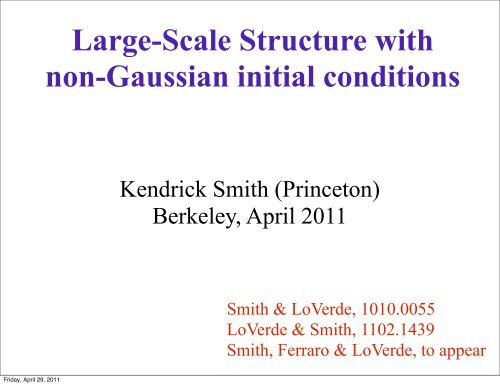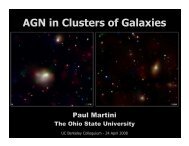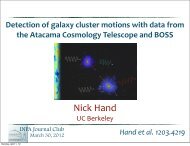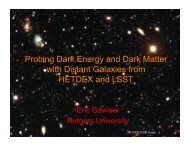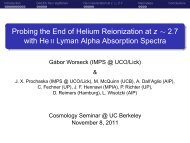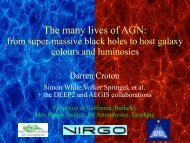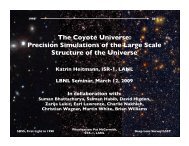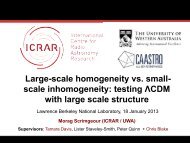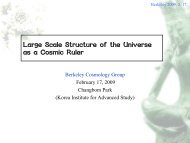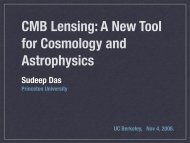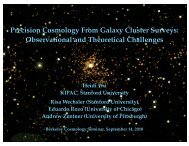Large-Scale Structure with non-Gaussian initial conditions
Large-Scale Structure with non-Gaussian initial conditions
Large-Scale Structure with non-Gaussian initial conditions
You also want an ePaper? Increase the reach of your titles
YUMPU automatically turns print PDFs into web optimized ePapers that Google loves.
Friday, April 29, 2011<br />
<strong>Large</strong>-<strong>Scale</strong> <strong>Structure</strong> <strong>with</strong><br />
<strong>non</strong>-<strong>Gaussian</strong> <strong>initial</strong> <strong>conditions</strong><br />
Kendrick Smith (Princeton)<br />
Berkeley, April 2011<br />
Smith & LoVerde, 1010.0055<br />
LoVerde & Smith, 1102.1439<br />
Smith, Ferraro & LoVerde, to appear
1. Introduction and motivation<br />
2. Halo mass function<br />
3. <strong>Large</strong>-scale halo clustering<br />
Friday, April 29, 2011<br />
Outline
Constraining inflation<br />
In the simplest models of inflation, the <strong>initial</strong> fluctuations are.....<br />
• nearly scale invariant<br />
• scalar<br />
• adiabatic<br />
• <strong>Gaussian</strong><br />
Friday, April 29, 2011<br />
(P (k) ∝ k ns−4 )
Constraining inflation<br />
In the simplest models of inflation, the <strong>initial</strong> fluctuations are.....<br />
• nearly scale invariant<br />
“running”?<br />
features/glitches?<br />
• scalar<br />
tensor modes (“r”)?<br />
• adiabatic<br />
isocurvature modes?<br />
• <strong>Gaussian</strong><br />
Friday, April 29, 2011<br />
(P (k) ∝ k ns−4 )<br />
(P (k) ∝ k ns−4+α log(k/k0) )<br />
primordial <strong>non</strong>-<strong>Gaussian</strong>ity?
1. Introduction and motivation<br />
2. Halo mass function<br />
3. <strong>Large</strong>-scale halo clustering<br />
Friday, April 29, 2011<br />
Outline
Friday, April 29, 2011<br />
Press-Schechter Model<br />
Start <strong>with</strong> linear density field<br />
δlin(x,z)
Friday, April 29, 2011<br />
Press-Schechter Model<br />
Apply threshhold: (halos of mass ≥ M) ⇔ (regions where δM (x,z) ≥ δc )<br />
δc =1.68<br />
δc =1.42<br />
motivated by analytic spherical collapse model<br />
gives better agreement <strong>with</strong> N-body simulations
Friday, April 29, 2011<br />
<strong>Gaussian</strong><br />
Non-<strong>Gaussian</strong> 1-point PDF<br />
Primordial <strong>non</strong>-<strong>Gaussian</strong>ity perturbs the 1-point PDF p(δM ) from a <strong>Gaussian</strong> distribution<br />
<strong>non</strong>-<strong>Gaussian</strong> <strong>non</strong>-<strong>Gaussian</strong><br />
Skewness<br />
Kurtosis<br />
∝ fNL<br />
∝ τNL<br />
p(δM )<br />
<strong>Gaussian</strong><br />
fNL cosmology gNL cosmology<br />
Skewness<br />
Kurtosis<br />
=0<br />
∝ gNL<br />
p(δM )
N-body simulations<br />
Collisionless N-body simulations, GADGET-2 TreePM code.<br />
Unless otherwise specified:<br />
- periodic boundary <strong>conditions</strong>,<br />
Lbox = 1600 h −1 Mpc<br />
- particle count<br />
N = 1024 3<br />
- force softening length<br />
Rs =0.05 (Lbox/N 1/3 )<br />
- <strong>initial</strong> <strong>conditions</strong> simulated at zini = 100<br />
using Zeldovich approximation<br />
- FOF halo finder, link length<br />
LFOF =0.2(Lbox/N 1/3 )<br />
Friday, April 29, 2011
Friday, April 29, 2011<br />
<strong>non</strong>-<strong>Gaussian</strong> correction<br />
Mass function: simulations<br />
τNL<br />
[ log-Edgeworth mass function looks better here! ]
Friday, April 29, 2011<br />
<strong>non</strong>-<strong>Gaussian</strong> correction<br />
Mass function: simulations<br />
gNL<br />
[ log-Edgeworth mass function looks better here too! ]
1. Introduction and motivation<br />
2. Halo mass function<br />
3. <strong>Large</strong>-scale halo clustering<br />
Friday, April 29, 2011<br />
Outline
Local <strong>non</strong>-<strong>Gaussian</strong>ity: large-scale clustering<br />
Dalal et al (2007): extra halo clustering on large scales in an cosmology<br />
fNL<br />
Clustering ∝ 1/α(k) , where<br />
α(k, z) = 2<br />
3<br />
satisfies<br />
k 2 T (k)D(z)<br />
ΩmH 2 0<br />
δlin(k,z)=α(k, z)Φ(k)<br />
Friday, April 29, 2011<br />
<strong>Large</strong>-scale structure constraints are competitive <strong>with</strong> the CMB<br />
Slosar et al (2008): fNL = 20 ± 25 (1σ) from SDSS-II<br />
What happens in a gNL or τNL cosmology?<br />
Dalal, Dore, Huterer & Shirokoff (2007)
<strong>Large</strong>-scale halo bias: <strong>Gaussian</strong> case<br />
Barrier crossing model: (halos of mass ≥ M) ⇔ (regions where δM ≥ δc)<br />
δM (x)<br />
How is halo abundance affected by the presence of a long-wavelength overdensity ?<br />
δl(x)<br />
Local halo overdensity<br />
Define halo bias b(k) = Pmh(k)<br />
Pmm(k)<br />
Friday, April 29, 2011<br />
b(k) → b0<br />
b0 =<br />
∂ log n<br />
∂δl<br />
δh ≈ b0δl<br />
∂ log n<br />
(where b0 = )<br />
∂δl<br />
δl(x)<br />
(as k → 0) (“weak” form of prediction)<br />
(“strong” prediction)<br />
δc<br />
δc<br />
δM (x)
Stochastic halo bias<br />
fNL cosmology<br />
τNL cosmology<br />
Local halo overdensity δh ≈ b0δl + fNLb1Φl<br />
b1<br />
α(k)<br />
Local halo overdensity δh ≈ b0δl + fNL<br />
β<br />
Halo bias b(k) → b0 + fNL<br />
Halo bias b(k) → b0 + fNL<br />
Friday, April 29, 2011<br />
b1<br />
α(k)<br />
Pmh(k) =b(k)Pmm(k) Pmh(k) =b(k)Pmm(k)<br />
Phh(k) =b(k) 2 Pmm(k)+ 1<br />
n<br />
Phh(k) =b(k) 2 Pmm(k)+ α2 f 2 NL<br />
β 2<br />
b1Φ (c)<br />
l<br />
b 2 1Pmm(k)<br />
α(k) 2<br />
Halos and matter not 100% correlated<br />
(“stochastic bias”)<br />
Different halo samples not 100% correlated<br />
1<br />
+<br />
n
Prediction from barrier crossing model:<br />
b(k) → b0 + fNL<br />
Halo bias: simulations<br />
fNL<br />
b1<br />
α(k)<br />
Agreement <strong>with</strong> simulations: perfect!<br />
Friday, April 29, 2011<br />
b1 =2δc(b0 − 1)<br />
z =0<br />
M>(1.0 × 10 14 ) h −1 M⊙
Friday, April 29, 2011<br />
Halo stochasticity: gNL simulations<br />
Preliminary


